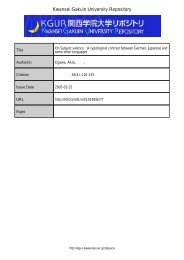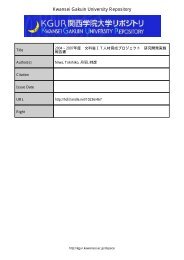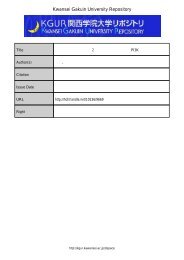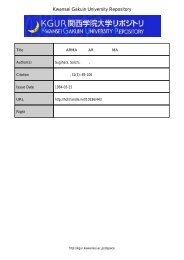Kwansei Gakuin University Repository
Kwansei Gakuin University Repository
Kwansei Gakuin University Repository
You also want an ePaper? Increase the reach of your titles
YUMPU automatically turns print PDFs into web optimized ePapers that Google loves.
Manufactures compiled by the Ministry of Economy, Trade, and Industry (METI). 6<br />
Data on research and development (R&D) intensity at roughly the three-digit SIC<br />
level are taken from the Results of Basic Survey of Japanese Business Structure and<br />
Activities by the METI. In addition, data on gross entry rate at the three-digit SIC<br />
level are obtained from the Establishment and Enterprise Census published by the<br />
Ministry of Internal Affairs and Communications (MIC). 7<br />
With respect to region-specific characteristics, we obtain data on the number<br />
of establishments for the two-digit SIC level at the prefecture level from the Estab-<br />
lishment and Enterprise Census. 8 As for regional economic conditions, we use data<br />
on the annual unemployment rate in each prefecture from the Labor Force Survey<br />
of the MIC.<br />
3.2. Different forms of exit<br />
As explained above, we classify exits into three forms—bankruptcy, voluntary liq-<br />
uidation, and merger—using the classifications in the TSR Data Bank. In this<br />
paper, ‘bankruptcy’ indicates the situation in which firms cannot repay their debts<br />
and thus cease operations. The bankruptcy group includes those firms applying for<br />
court protection under the Bankruptcy Law, as well as those applying for it under<br />
the Corporate Rehabilitation Law and the Civil Rehabilitation Law enacted in Japan<br />
in April 2000. In addition, firms whose bills payable are no longer honored by banks<br />
6 Unfortunately, industrial classifications changed during the observation period, and for several<br />
industries, we could not match the classifications at the three-digit SIC level between the periods<br />
before and after the changes in the SIC. For these industries, we used data at the two-digit SIC<br />
level, instead of the three-digit SIC level. In addition, when data were not available for a year at<br />
the three-digit SIC level, because data were concealed for reasons of confidentiality, we used instead<br />
the average values for these industries in other years during the observation period or values at the<br />
two-digit SIC level.<br />
7 The Establishment and Enterprise Census surveys gross entry rates every three or five years.<br />
Therefore, we used the values of gross entry rates between 1996 and 2001 divided by five for firms<br />
founded during the period 1997 to 2001 and the values of gross entry rate between 2001 and 2004<br />
divided by three for firms founded during the period 2002 to 2004.<br />
8 Because the values of the number of establishments at the two-digit SIC level are available for<br />
1996 and 2001, we used the values in 1996 for firms founded during the period 1997 to 2000 and<br />
the values in 2001 for firms founded during the period 2001 to 2004.<br />
9
















